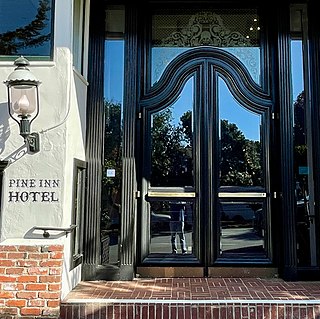
Pine Inn, once called the Hotel Carmelo, is one of the early first-class Arts and Crafts, Tudor, Spanish style hotels established in Carmel-by-the-Sea, California. The Pine Inn is a historical resource dating back to 1889 when pioneer Santiago J. Duckworth built Hotel Carmelo. James Franklin Devendorf, renamed the hotel the "Pine Inn" in 1904. Today, it is a full-service hotel. The Pine Inn qualified for inclusion in the city's Downtown Historic District Property Survey, and was registered with the California Register of Historical Resources on March 18, 2003. The Inn is significant under the California Register criterion 1, as the first hotel in the history of the downtown district of Carmel-by-the-Sea.

The Las Tiendas Building is a two-story reinforced Spanish Eclectic style commercial building in downtown Carmel-by-the-Sea, California. The building is the best and only example of Spanish Eclectic commercial design by the architectural firm of Swartz & Ryland in Carmel. It has been designated as an important commercial building in the city's downtown historic district property survey; and was registered with the California Register of Historical Resources on February 15, 2003. The building has been occupied by the Club since 2006.

The Kocher Building, also known as La Giralda is a two-story steel and concrete framed Spanish Eclectic style commercial building in Carmel-by-the-Sea, California. It was designated as an important commercial building in the city's Downtown Historic District Property Survey, on September 4, 2002. The building is occupied by La Bicyclette Restaurant on the ground floor.

The La Ribera Hotel, also known as the Cypress Inn, is a historic Spanish Eclectic hotel in Carmel-by-the-Sea, California. It was designed by architects Blaine & Olsen of Oakland, California and built in 1929, by Meese & Briggs. The building was designated as a significant commercial building in the city's Downtown Historic District Property Survey, and was recorded with the Department of Parks and Recreation on February 13, 2003.

The Seven Arts Shop, is a one-story, wood-frame Tudor Storybook retail shop in Carmel-by-the-Sea, California. During the 1930s, the building served as the reading room for the Christian Science organization. It has been designated as a significant commercial building in the city's Downtown Historic District Property Survey, and was recorded with the Department of Parks and Recreation on January 23, 2002. The building is occupied in 2022 by the beauty supply company Body Frenzy.

The Seven Arts Building, is a one-and-one-half-story, commercial building in downtown Carmel-by-the-Sea, California. It was built in 1925, for poet mayor Herbert Heron. The building was designated as a significant commercial building in the city's Downtown Historic District Property Survey, and was recorded with the Department of Parks and Recreation on January 31, 2003. The building has been occupied by the Carmel Bay Company since 1972.

Sade's is a one-and-one-half-story, commercial building in downtown Carmel-by-the-Sea, California. It was built in 1925, for novelist and dramatist Harry Leon Wilson and his wife Helen MacGowan Cooke as a flower shop and dress shop. In the 1930s, Sade was a former Ziegfeld Follies dancer, made the lower level into a restaurant and bar that was nationally renowned. The building was designated as a significant commercial building in the city's Downtown Historic District Property Survey, and was recorded with the Department of Parks and Recreation on January 28, 2002. The first floor of the building is now occupied by the Porta Bella Mediterranean restaurant and bar. The second floor is occupied by Kids by the Sea.
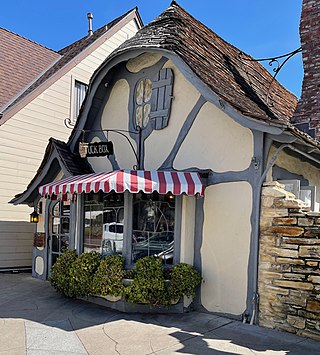
The Tuck Box is a historic Craftsman Storybook style commercial building in downtown Carmel-by-the-Sea, California, United States. It was built in 1926, by master builder Hugh W. Comstock. The building was designated as a significant commercial building in the city's Downtown Historic District Property Survey, and was recorded with the Department of Parks and Recreation on October 8, 2002. The Tuck Box continues today as an English tea shop.

The Garden Shop Addition is a historic Craftsman commercial building in downtown Carmel-by-the-Sea, California. The kiosk was designed and built in 1931, by master builder Hugh W. Comstock, and is adjacent to The Tuck Box and the Lemos Building. The shop was designated as a significant commercial building in the city's Downtown Historic District Property Survey, and was recorded with the Department of Parks and Recreation on October 8, 2002. The building is occupied by Exclusive Realty.
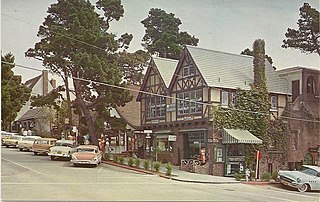
The Amelia Gates Building is a historic two-story wood-framed Tudor Revival style commercial building in downtown Carmel-by-the-Sea, California. The building is significant as one of the two known designs by Amelia L. Gates. The building qualified as an important commercial building in the city's downtown historic district property survey and was registered with the California Register of Historical Resources on February 13, 2002. The building is occupied by the Kashmir Treasures and the MEUSE art gallery.
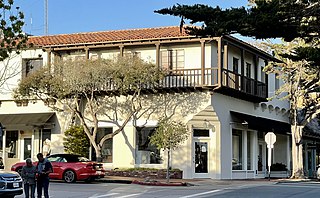
The Goold Building is a historic two-story concrete commercial building in downtown Carmel-by-the-Sea, California. The building is an example of Spanish Colonial Revival and Monterey Colonial styles. The building qualified as an important commercial building in the city's downtown historic district property survey and was registered with the California Register of Historical Resources on February 3, 2003. The building has occupied the Coach Outlet since the 1990s.

The Bernard Wetzel Building is a historic commercial building in downtown Carmel-by-the-Sea, California. It is an example of Spanish Eclectic Revival style architecture. The building qualified as an important building in the city's downtown historic district property survey and was registered with the California Register of Historical Resources on September 7, 2004. The building has been occupied by Whittakers since 1989.

The Doud Building, also known as the James Doud Building is a historic commercial building in Carmel-by-the-Sea, California. James Cooper Doud established the building in 1932, built by master builder Michael J. Murphy as a mixed-use retail shop and residence. It is an example of a Spanish Colonial Revival architecture style building. The structure is recognized as an important commercial building in the city's Downtown Conservation District Historic Property Survey, and was nominated and submitted to the California Register of Historical Resources on February 21, 2003. The building is now occupied by the Mad Dogs & Englishmen Bike Shop and the Carmel Sport clothing store.

The Isabel Leidig Building is a historic commercial building in Carmel-by-the-Sea, California. It was built and designed in 1925, by master builder Michael J. Murphy as a restaurant. It is an example of a mix of Monterey colonial style with Spanish Colonial Revival. The structure is recognized as an important commercial building in the city's Downtown Conservation District Historic Property Survey, and was nominated and submitted to the California Register of Historical Resources on June 18, 2002. The building is occupied by Mulligan Public House pub and Gallery North.
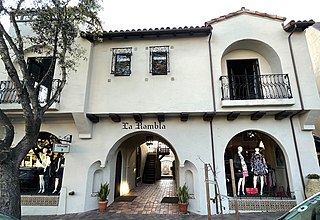
The La Rambla Building is a historic commercial building, built in 1929, in Carmel-by-the-Sea, California. The structure is recognized as an important Spanish Eclectic-style building in the city's Downtown Conservation District Historic Property Survey, and was nominated and submitted to the California Register of Historical Resources on January 30, 2003.
The following is a timeline of the history of Carmel-by-the-Sea, California, United States.

Lee Gottfried was an American master builder in Carmel-by-the-Sea, California. He had a significant influence on the architecture of the Village of Carmel during his career. Gottfried was one of the main local builders in Carmel and responsible for the first major residential designs done using the local Carmel stone as a building material.

Guy Oran Koepp was an American architect known for his distinctive designs in Carmel-by-the-Sea, California. He played a significant role in shaping the city's character and architecture. Some of his notable works in downtown Carmel include the Coach Building, La Rambla Building, and the old Carmel Dairy.





















